上海交通大学:《力学仿生——启示与探索》课程教学资源(论文资料)陆地仿生_2014-混合驱动型腿部机构的设计与实验研究

中国科学枝术大学 硕士学位论文 混合驱动型腿部机构的 设计与实验研究 作者姓名: 王浩 学科专业: 机械电子工程 导师姓名: 杨杰教授董二宝副教授 完成时间: 二O一四年五月十六日
中国科学技术大学 硕士学位论又 混合驱动型腿部机构的 设计与实验研究 作者姓名: 学科专业: 导师姓名: 完成时间: 王浩 机械电子工程 杨杰教授董二宝副教授 二。一四年五月十六日
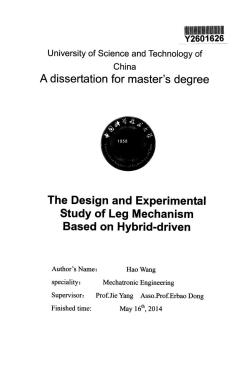
Y2601626 University of Science and Technology of China A dissertation for master's degree 大 1958 The Design and Experimental Study of Leg Mechanism Based on Hybrid-driven Author's Name: Hao Wang speciality: Mechatronic Engineering Supervisor: Prof.Jie Yang Asso.Prof.Erbao Dong Finished time: May16,2014
I啪1111111111111111MIIMlllllIIillllll Y2601 626 University of Science and Technology of China A d issertation for master’S deg ree The Design and Experimental Study of Leg Mechanism Based on Hybrid_—driven Author’S Name:Hao Wang speciality: Mechatronic Engineering 一 一 Supervisor:Prof.Jie Yang Asso.Prof.Erbao Dong Finished time: May 16m,2014
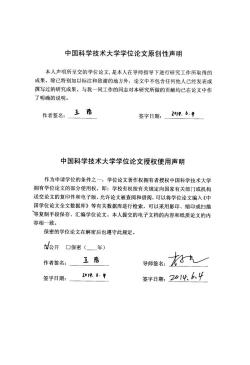
中国科学技术大学学位论文原创性声明 本人声明所呈交的学位论文,是本人在导师指导下进行研究工作所取得的 成果。除已特别加以标注和致谢的地方外,论文中不包含任何他人己经发表或 撰写过的研究成果。与我一同工作的同志对本研究所做的贡献均已在论文中作 了明确的说明。 作者签名: 王浩 签字日期: 219.6.9 中国科学技术大学学位论文授权使用声明 作为申请学位的条件之一,学位论文著作权拥有者授权中国科学技术大学 拥有学位论文的部分使用权,即:学校有权按有关规定向国家有关部门或机构 送交论文的复印件和电子版,允许论文被查阅和借阅,可以将学位论文编入《中 国学位论文全文数据库》等有关数据库进行检索,可以采用影印、缩印或扫描 等复制手段保存、汇编学位论文。本人提交的电子文档的内容和纸质论文的内 容相一致。 保密的学位论文在解密后也遵守此规定。 山公开 口保密(年) 作者签名: 王浩 导师签名: 签字日期: 2019.6.9 签字日期: 2®1K6.9
中国科学技术大学学位论文原创性声明 本人声明所呈交的学位论文,是本人在导师指导下进行研究工作所取得的 成果。除已特别加以标注和致谢的地方外,论文中不包含任何他人已经发表或 撰写过的研究成果。与我一同工作的同志对本研究所做的贡献均己在论文中作 了明确的说明。 作者签名:'睁 签字日期: 20J9.b·, 中国科学技术大学学位论文授权使用声明 作为申请学位的条件之一,学位论文著作权拥有者授权中国科学技术大学 拥有学位论文的部分使用权,即:学校有权按有关规定向国家有关部门或机构 送交论文的复印件和电子版,允许论文被查阅和借阅,可以将学位论文编入《中 国学位论文全文数据库》等有关数据库进行检索,可以采用影印、缩印或扫描 ’等复制手段保存、汇编学位论文。本人提交的电子文档的内容和纸质论文的内 容相一致。 保密的学位论文在解密后也遵守此规定。 , 凹公开 口保密(——年) 作者签名: 王冶 签字日期: 2。¨。6‘l『 导师签名: 签字日期: 矽f收多。驴
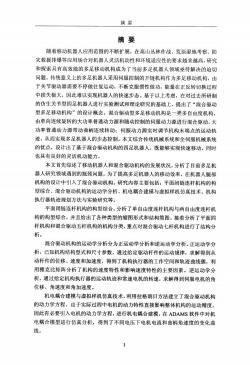
摘要 摘要 随着移动机器人应用范围的不断扩展,在高山丛林作战、荒原湿地考察、防 灾救援排爆等应用场合对机器人灵活机动性和环境适应性的要求越来越高,研究 和探索具有高效能的多足移动机构成为了当前多足机器人领域亟待解决的迫切 问题。传统意义上的多足机器人采用伺服控制的开链机构作为多足移动机构,由 于关节驱动器需要不停做往复运动,不断克服惯性做功,能量在正反转切换过程 中损失极大,因此难以实现机器人的快速步态。基于以上考虑,在对过去所研制 的仿生关节型四足机器人进行实验测试和理论研究的基础上,提出了“混合驱动 型多足移动机构”的设计概念。混合驱动型多足移动机构是一类多自由度机构, 由单向连续旋转的大功率普通动力源和随动控制的伺服动力源进行混合驱动,大 功率普通动力源带动曲柄连续转动;伺服动力源实时调节机构末端点的运动轨 迹,从而实现多足机器人的步态控制。本文综合传统机械系统和全伺服机械系统 的优点,设计出了基于混合驱动机构的四足机器人,既能够实现快速移动,同时 也具有良好的灵活机动能力。 本文首先综述了移动机器人和混合驱动机构的发展状况,分析了目前多足机 器人研究领域遇到的瓶颈问题。为了提高多足机器人的移动效率,在机器人腿部 机构的设计中引入了混合驱动机构。研究内容主要包括:平面闭链连杆机构的构 型综合、混合驱动机构的运动学分析、机电耦合建模与虚拟样机仿真技术、机构 执行器轨迹规划方法与实验研究等。 平面闭链连杆机构的构型综合,分析了单自由度连杆机构与两自由度连杆机 构的构型综合,并且给出了各种类型的缩图形式和结构简图。接着分析了平面四 杆机构和混合驱动五杆机构的机构分类,重点对混合驱动七杆机构进行了结构分 析。 混合驱动机构的运动学分析分为正运动学分析和逆运动学分析。正运动学分 析,己知机构结构型式和尺寸参数,通过给定驱动杆件的运动规律,求解得到从 动杆件的位移、速度和加速度,得到了机构执行器的工作空间和轨迹曲线簇,利 用雅克比矩阵分析了机构的速度特性和影响速度特性的主要因素。逆运动学分 析,通过给定机构执行器的运动轨迹和常速电机的转速,求解得到同服电机的角 位移、角速度和角加速度。 机电耦合建模与虚拟样机仿真技术,利用拉格朗日方法建立了混合驱动机构 的动力学方程。由于实际过程中电机的动力特性直接影响整体机构的运动精度, 因此有必要引入电机的动力学方程,进行机电耦合建模。在ADAMS软件中对机 电耦合模型进行仿真分析,得到了不同电压下电机电流和曲柄角速度的变化曲 线。 I
摘要 摘要 随着移动机器人应用范围的不断扩展,在高山丛林作战、荒原湿地考察、防 灾救援排爆等应用场合对机器人灵活机动性和环境适应性的要求越来越高,研究 和探索具有高效能的多足移动机构成为了当前多足机器人领域亟待解决的迫切 问题。传统意义上的多足机器人采用伺服控制的开链机构作为多足移动机构,由 于关节驱动器需要不停做往复运动,不断克服惯性做功,能量在正反转切换过程 中损失极大,因此难以实现机器人的快速步态。基于以上考虑,在对过去所研制 的仿生关节型四足机器人进行实验测试和理论研究的基础上,提出了“混合驱动 型多足移动机构”的设计概念。混合驱动型多足移动机构是一类多自由度机构, 由单向连续旋转的大功率普通动力源和随动控制的伺服动力源进行混合驱动,大 功率普通动力源带动曲柄连续转动;伺服动力源实时调节机构末端点的运动轨 迹,从而实现多足机器人的步态控制。本文综合传统机械系统和全伺服机械系统 的优点,设计出了基于混合驱动机构的四足机器人,既能够实现快速移动,同时 也具有良好的灵活机动能力。 本文首先综述了移动机器人和混合驱动机构的发展状况,分析了目前多足机 器人研究领域遇到的瓶颈问题。为了提高多足机器人的移动效率,在机器人腿部 机构的设计中引入了混合驱动机构。研究内容主要包括:平面闭链连杆机构的构 型综合、混合驱动机构的运动学分析、机电耦合建模与虚拟样机仿真技术、机构 执行器轨迹规划方法与实验研究等。 平面闭链连杆机构的构型综合,分析了单自由度连杆机构与两自由度连杆机 构的构型综合,并且给出了各种类型的缩图形式和结构简图。接着分析了平面四 杆机构和混合驱动五杆机构的机构分类,重点对混合驱动七杆机构进行了结构分 析。 混合驱动机构的运动学分析分为正运动学分析和逆运动学分析。正运动学分 析,已知机构结构型式和尺寸参数,通过给定驱动杆件的运动规律,求解得到从 动杆件的位移、速度和加速度,得到了机构执行器的工作空间和轨迹曲线簇,利 用雅克比矩阵分析了机构的速度特性和影响速度特性的主要因素。逆运动学分 析,通过给定机构执行器的运动轨迹和常速电机的转速,求解得到伺服电机的角 位移、角速度和角加速度。 机电耦合建模与虚拟样机仿真技术,利用拉格朗日方法建立了混合驱动机构 的动力学方程。由于实际过程中电机的动力特性直接影响整体机构的运动精度, 因此有必要引入电机的动力学方程,进行机电耦合建模。在ADAMS软件中对机 电耦合模型进行仿真分析,得到了不同电压下电机电流和曲柄角速度的变化曲 线

摘要 机构执行器轨迹规划方法与实验研究,分别介绍了基于逆运动学分析和基于 轨迹曲线簇的轨迹规划方法。利用混合驱动五杆机构实验平台对以上两种方法进 行了实验研究,得到了圆形轨迹的误差曲线。出于七杆机构构型上的特殊性,腿 部机构特定轨迹实现采用的是基于轨迹曲线簇的方法,利用机器人腿部机构实验 平台进行了四种不同轨迹的实验研究,实验结果验证了方法的可行性。 论文最后总结了研究工作的主要结论,同时对后续工作提出了一些展望,以 期更加深入的研究混合驱动机构。 关键词:多足机器人混合驱动机构工作空间轨迹规划实验研究
摘要 机构执行器轨迹规划方法与实验研究,分别介绍了基于逆运动学分析和基于 轨迹曲线簇的轨迹规划方法。利用混合驱动五杆机构实验平台对以上两种方法进 行了实验研究,得到了圆形轨迹的误差曲线。由于七杆机构构型上的特殊性,腿 部机构特定轨迹实现采用的是基于轨迹曲线簇的方法,利用机器人腿部机构实验 平台进行了四种不同轨迹的实验研究,实验结果验证了方法的可行性。 论文最后总结了研究工作的主要结论,同时对后续工作提出了一些展望,以 期更加深入的研究混合驱动机构。 关键词:多足机器人混合驱动机构 工作空间 轨迹规划 实验研究 II
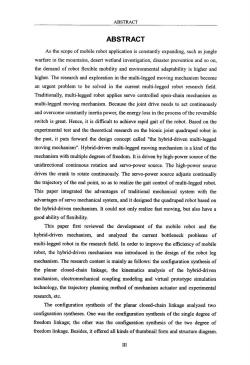
ABSTRACT ABSTRACT As the scope of mobile robot application is constantly expanding,such as jungle warfare in the mountains,desert wetland investigation,disaster prevention and so on, the demand of robot flexible mobility and environmental adaptability is higher and higher.The research and exploration in the multi-legged moving mechanism become an urgent problem to be solved in the current multi-legged robot research field. Traditionally,multi-legged robot applies servo controlled open-chain mechanism as multi-legged moving mechanism.Because the joint drive needs to act continuously and overcome constantly inertia power,the energy loss in the process of the reversible switch is great.Hence,it is difficult to achieve rapid gait of the robot.Based on the experimental test and the theoretical research on the bionic joint quadruped robot in the past,it puts forward the design concept called "the hybrid-driven multi-legged moving mechanism".Hybrid-driven multi-legged moving mechanism is a kind of the mechanism with multiple degrees of freedom.It is driven by high-power source of the unidirectional continuous rotation and servo-power source.The high-power source drives the crank to rotate continuously.The servo-power source adjusts continually the trajectory of the end point,so as to realize the gait control of multi-legged robot. This paper integrated the advantages of traditional mechanical system with the advantages of servo mechanical system,and it designed the quadruped robot based on the hybrid-driven mechanism.It could not only realize fast moving,but also have a good ability of flexibility. This paper first reviewed the development of the mobile robot and the hybrid-driven mechanism,and analyzed the current bottleneck problems of multi-legged robot in the research field.In order to improve the efficiency of mobile robot,the hybrid-driven mechanism was introduced in the design of the robot leg mechanism.The research content is mainly as follows:the configuration synthesis of the planar closed-chain linkage,the kinematics analysis of the hybrid-driven mechanism,electromechanical coupling modeling and virtual prototype simulation technology,the trajectory planning method of mechanism actuator and experimental research,etc. The configuration synthesis of the planar closed-chain linkage analyzed two configuration syntheses.One was the configuration synthesis of the single degree of freedom linkage;the other was the configuration synthesis of the two degree of freedom linkage.Besides,it offered all kinds of thumbnail form and structure diagram. I
ABSTRACT ABSTRACT As the scope of mobile robot application is constantly expanding,such as jungle warf打e in the mountains,desert wetland investigation,disaster prevention and SO on, the demand of robot flexible mobility and environmental adaptability is higher and higher.The research and exploration in the multi-legged moving mechanism become an urgent Droblem to be solved in the current multi—legged robot research field. Traditionally,multi.1egged robot applies servo controlled open’chain mechanism as multi.1egged moving mechanism.Because the joint drive needs to act continuously and overcome constantly inertia power,the energy loss in the process of the reversible switch is great.Hence,it is difficult to achieve rapid gait of the robot.Based on the experimental test and the theoretical research on the bionic joint quadruped robot in the past,it puts forward the design concept called”the hybrid-driven multi-legged moving mechanism”.Hybrid.driven multi.1egged moving mechanism is a kind of the mechanism with multiple degrees of freedom.It is driven by high。power source of the unidirectional continuous rotation and servo-power source.The high‘power source drives me crank to rotate continuously.The servo-power source adjusts continually the trajectory of the end point,SO as tO realize the gait control of multi—legged robot. This paper integrated the advantages of traditional mechanical system with the advantages of servo mechanical system,and it designed the quadruped robot based on the hybrid.driven mechanism.It could not only realize fast moving,but also have a good ability of flexibility. This paper first reviewed the development of the mobile robot and the hybrid.driven mechanism,and analyzed the current bottleneck problems of multi..1egged robot in the research field.In order to improve the efficiency of mobile robot.the hybrid.driven mechanism was introduced in the design of the robot leg mechallism.The research content is mainly as follows:the configuration synthesis of tlle planar closed.chain linkage,the kinematics analysis of the hybrid-driven mec_h砸sm,electromechanical coupling modeling and virtual prototype simulation technology,the trajectory planning method of mechanism actuator and experimental research,etc. The configuration synthesis of the planar closed-chain linkage analyzed two configuration syntheses.One was the configuration synthesis of the single degree of freedom linkage;the other was the configuration synthesis of the two degree of freedom linkage.Besides,it offered all kinds of thumbnail form and structure diagram· III
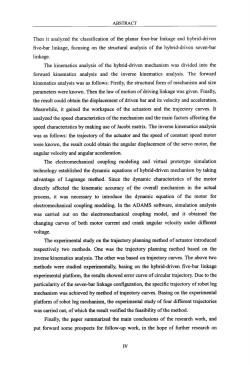
ABSTRACT Then it analyzed the classification of the planar four-bar linkage and hybrid-driven five-bar linkage,focusing on the structural analysis of the hybrid-driven seven-bar linkage. The kinematics analysis of the hybrid-driven mechanism was divided into the forward kinematics analysis and the inverse kinematics analysis.The forward kinematics analysis was as follows:Firstly,the structural form of mechanism and size parameters were known.Then the law of motion of driving linkage was given.Finally, the result could obtain the displacement of driven bar and its velocity and acceleration. Meanwhile,it gained the workspace of the actuators and the trajectory curves.It analyzed the speed characteristics of the mechanism and the main factors affecting the speed characteristics by making use of Jacobi matrix.The inverse kinematics analysis was as follows:the trajectory of the actuator and the speed of constant speed motor were known,the result could obtain the angular displacement of the servo motor,the angular velocity and angular acceleration. The electromechanical coupling modeling and virtual prototype simulation technology established the dynamic equations of hybrid-driven mechanism by taking advantage of Lagrange method.Since the dynamic characteristics of the motor directly affected the kinematic accuracy of the overall mechanism in the actual process,it was necessary to introduce the dynamic equation of the motor for electromechanical coupling modeling.In the ADAMS software,simulation analysis was carried out on the electromechanical coupling model,and it obtained the changing curves of both motor current and crank angular velocity under different voltage. The experimental study on the trajectory planning method of actuator introduced respectively two methods.One was the trajectory planning method based on the inverse kinematics analysis.The other was based on trajectory curves.The above two methods were studied experimentally,basing on the hybrid-driven five-bar linkage experimental platform,the results showed error curve of circular trajectory.Due to the particularity of the seven-bar linkage configuration,the specific trajectory of robot leg mechanism was achieved by method of trajectory curves.Basing on the experimental platform of robot leg mechanism,the experimental study of four different trajectories was carried out,of which the result verified the feasibility of the method. Finally,the paper summarized the main conclusions of the research work,and put forward some prospects for follow-up work,in the hope of further research on V
ABSTRACT Then it analyzed the classification of the planar four-bar linkage and hybrid—driven five.bar linkage。focusing on the structural analysis of the hybrid-driven seven-bar linkage. The kinematics analysis of the hybrid.driven mechanism was divided into the forward kinematics analysis and the inverse kinematics analysis.The forward kinematics analysis was as follows:Firstly,the structural form of mechanism and size par锄eters were known.Then the law of motion of driving linkage was given.Finally, the result could obtain the displacement of driven bar and its velocity and acceleration. Meanwhile,it gained the workspace of the actuators and the trajectory curves.It analyzed the speed characteristics of the mechanism and the main factors affecting the speed characteristics by making use of Jacobi matrix.The inverse kinematics analysis was as follows:the trajectory of the actuator and the speed of constant speed motor were known.me result could obtain the angular displacement of the servo motor,the angular velocity and angular acceleration. The electromechanical coupling modeling and virtual prototype simulation technology established the dynamic equations of hybrid-driven mechanism by taking advantage of Lagrange method.Since the dynamic characteristics of the motor directlv affected the kinematic accuracy of the overall mechanism in the actual process,it was necessary to introduce the dynamic equation of the motor for electromechanical coupling modeling.In the ADAMS software,simulation analysis was carried out on the electromechanical coupling model, and it obtained the changing curves of both motor current and crank angular velocity under different voltage. The experimental study on the trajectory planning method of actuator introduced respectivelv two methods.One was the trajectory planning method based on the inverse kinematics analysis.The other Was based on trajectory curves.The above two methods were studied experimentally,basing on the hybrid—driven five-bar linkage experimental platform,the results showed error curve of circular trajectory.Due to the particularity of the seven-bar linkage configuration,the specific trajectory of robot leg mechanism was achieved by method of trajectory curves.Basing on the experimental platform of robot leg mechanism,the experimental study of four different trajectories was c秭ed out.of which the result verified the feasibility of the method. Finally,the paper summarized the main conclusions of the research work,and put forward some prospects for follow-up work,in the hope of further research on IV

ABSTRACT hybrid-driven mechanism. Key Words:multi-legged robot,hybrid-driven mechanism,workspace trajectory planning,experimental study V
ABSTRACT hybrid-driven mechanism. Key Words:multi-legged robot,hybrid—driven mechanism,workspace traj ectory planning,experimental study V

ABSTRACT VI
ABSTRACT VI
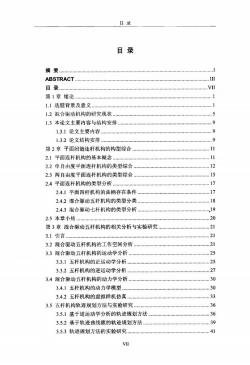
日求 目录 是1tt144 I ABSTRACT... In 目录… 第1章绪论 .1 1.1选题背景及意义… 1.2混合驱动机构的研究现状… 1.3本论文主要内容与结构安排… 9 1.3.1论文主要内容.… 9 1.32论文结构安排… 9 第2章平面闭链连杆机构的构型综合… 11 2.1平面连杆机构的基本概念 2.2单自由度平面连杆机构的类型综合12 2.3两自由度平面连杆机构的类型综合… .15 2.4平面连杆机构的类型分析… .17 2.4.1平面四杆机构的曲柄存在条件.17 2.4.2混合驱动五杆机构的类型分类… 18 2.4.3混合驱动七杆机构的类型分析… ,19 2.5本章小结 …20 第3章混合驱动五杆机构的相关分析与实验研究…21 31引言… …21 3.2混合驱动五杆机构的工作空间分析… …21 3.3混合驱动五杆机构的运动学分析… 25 3.3.1五杆机构的正运动学分析… 25 3.3.2五杆机构的逆运动学分析. 27 34混合驱动五杆机构的动力学分析… 30 3.4.1五杆机构的动力学模型… 30 3.4.2五杆机构的虚拟样机仿真.… .33 3.5五杆机构轨迹规划方法与实验研究.… .36 3.5.1基于逆运动学分析的轨迹规划方法. 36 3.5.2基于轨迹曲线簇的轨迹规划方法… .39 3.5.3轨迹规划方法的实验研究… A VII
按次数下载不扣除下载券;
注册用户24小时内重复下载只扣除一次;
顺序:VIP每日次数-->可用次数-->下载券;
- 上海交通大学:《力学仿生——启示与探索》课程教学资源(论文资料)陆地仿生_2014-基于异形轮组合的小型机器人越障性能研究.pdf
- 上海交通大学:《力学仿生——启示与探索》课程教学资源(论文资料)陆地仿生_2014-Rolling-Wolf轮腿式机器人设计及优化.pdf
- 上海交通大学:《力学仿生——启示与探索》课程教学资源(论文资料)陆地仿生_2013-蝗虫起跳运动分析及其仿生跳跃机构研究.pdf
- 上海交通大学:《力学仿生——启示与探索》课程教学资源(论文资料)陆地仿生_2013-基于气动肌肉驱动的仿蛙腿跳跃机构控制系统研究.pdf
- 上海交通大学:《力学仿生——启示与探索》课程教学资源(论文资料)陆地仿生_2013-仿青蛙跳跃机器人稳定跳跃的研究.pdf
- 上海交通大学:《力学仿生——启示与探索》课程教学资源(论文资料)陆地仿生_2012-蝗虫抓附及跳跃的运动力学测试与建模分析.pdf
- 上海交通大学:《力学仿生——启示与探索》课程教学资源(论文资料)陆地仿生_2012-新型气动仿青蛙机器人设计及弹跳性能研究.pdf
- 上海交通大学:《力学仿生——启示与探索》课程教学资源(论文资料)陆地仿生_2010-仿蝗虫跳跃机器人运动学、动力学研究及仿生关节设计.pdf
- 上海交通大学:《力学仿生——启示与探索》课程教学资源(论文资料)陆地仿生_2009-仿生蛇的设计及其运动仿真.pdf
- 上海交通大学:《力学仿生——启示与探索》课程教学资源(论文资料)陆地仿生_2007-仿生机器蛙跳跃机理分析及运动仿真.pdf
- 上海交通大学:《力学仿生——启示与探索》课程教学资源(论文资料)水下仿生_水平轴潮流能水轮机仿生鲨鱼鳍叶片的设计及水动力性能研究.pdf
- 上海交通大学:《力学仿生——启示与探索》课程教学资源(论文资料)水下仿生_水下仿生滑翔机器人机构设计及水动力学分析.pdf
- 上海交通大学:《力学仿生——启示与探索》课程教学资源(论文资料)水下仿生_基于章鱼仿生的柔性臂建模与控制.pdf
- 上海交通大学:《力学仿生——启示与探索》课程教学资源(论文资料)水下仿生_仿生螺旋桨水动力性能研究.pdf
- 上海交通大学:《力学仿生——启示与探索》课程教学资源(论文资料)水下仿生_仿生尾鳍推进机理分析与减阻研究.pdf
- 上海交通大学:《力学仿生——启示与探索》课程教学资源(论文资料)水下仿生_一种超磁机器鱼的设计和游动控制的数值模拟.pdf
- 上海交通大学:《力学仿生——启示与探索》课程教学资源(论文资料)水下仿生_SMA驱动仿生机器鱼的尾鳍和喷射推进性能及其实验研究.pdf
- 上海交通大学:《力学仿生——启示与探索》课程教学资源(论文资料)水下仿生_2012基于柔性鳍波动的水下仿生系统推进性能研究.pdf
- 上海交通大学:《力学仿生——启示与探索》课程教学资源(论文资料)水下仿生_2009-多足仿生机器蟹结构设计及实验研究.pdf
- 上海交通大学:《力学仿生——启示与探索》课程教学资源(论文资料)水下仿生_2009-基于形状记忆合金的仿生鳍条结构设计及实验研究.pdf
- 上海交通大学:《力学仿生——启示与探索》课程教学资源(论文资料)陆地仿生_仿生水黾水面跳跃机器人的研究.pdf
- 上海交通大学:《力学仿生——启示与探索》课程教学资源(论文资料)陆地仿生_大壁虎斜面运动力学、脚趾外翻脱附力学及其仿生研究.pdf
- 上海交通大学:《力学仿生——启示与探索》课程教学资源(论文资料)陆地仿生_自适应性主动式下肢假肢仿生控制方法研究.pdf
- 上海交通大学:《力学仿生——启示与探索》课程教学资源(论文资料)陆地仿生_贻贝仿生功能化材料制备及其吸附性能研究.pdf
- 上海交通大学:《力学仿生——启示与探索》课程教学资源(论文资料)飞行仿生_2007-新型空间悬挑结构仿生(蜻蜓翅膀)设计研究.pdf
- 上海交通大学:《力学仿生——启示与探索》课程教学资源(论文资料)飞行仿生_2007-蜻蜓翅翼拍动机理研究和模拟装置研制.pdf
- 上海交通大学:《力学仿生——启示与探索》课程教学资源(论文资料)飞行仿生_2012-仿生扑翼飞行器设计及空气动力特性研究.pdf
- 上海交通大学:《力学仿生——启示与探索》课程教学资源(论文资料)飞行仿生_2014-仿蝴蝶微型扑翼机飞行原理及扑翼机构研究.pdf
- 上海交通大学:《力学仿生——启示与探索》课程教学资源(论文资料)飞行仿生_仿生微型扑翼飞行器的结构设计与研制.pdf
- 上海交通大学:《力学仿生——启示与探索》课程教学资源(论文资料)飞行仿生_仿生扑翼飞行器柔性翅翼及驱动机构的研究.pdf
- 上海交通大学:《力学仿生——启示与探索》课程教学资源(论文资料)飞行仿生_机器海鸥的仿生设计及其实验研究.pdf
- 上海交通大学:《力学仿生——启示与探索》课程教学资源_01_绪论.ppt
- 上海交通大学:《力学仿生——启示与探索》课程教学资源_10力学仿生第一次作业_吴宇峻_基于仿跳蛛的多足行进机构设想.pptx
- 上海交通大学:《力学仿生——启示与探索》课程教学资源_11力学仿生第一次作业_尹浩_让水上漂成为现实.pptx
- 上海交通大学:《力学仿生——启示与探索》课程教学资源_12力学仿生第一次作业_邹斌_借力漩涡.ppt
- 上海交通大学:《力学仿生——启示与探索》课程教学资源_13力学仿生第一次作业安泰秦源517120910140.pptx
- 上海交通大学:《力学仿生——启示与探索》课程教学资源_13力学仿生第一次作业安泰秦源517120910140.pptx
- 上海交通大学:《力学仿生——启示与探索》课程教学资源_14力学仿生第一次作业李明玥.pptx
- 上海交通大学:《力学仿生——启示与探索》课程教学资源_14力学仿生第一次作业李明玥.pptx
- 上海交通大学:《力学仿生——启示与探索》课程教学资源_15力学仿生第一次作业骆曼箬.pptx
